This $2 Billion Water Battery Could Give Green Energy An Astonishing Backup
Global climate change is an increasingly formidable problem that's responsible for the drastic uptick of intense wildfires and hurricanes across the United States, to name just a few runaway environmental disasters exasperated across the planet by excess CO2 levels. Scientists and engineers are trying to solve the global climate crisis in their own unique ways — for example, researchers in Finland came up with this sand-based battery that traps excess thermal energy in large silos (thermal energy that would otherwise be wasted!), reducing output demand from power plants. The climate crisis has also given rise to an increase in electric vehicle production from many of the world's top car manufacturers.
As demonstrated by the aforementioned sand battery, one way to decrease the negative effects of global climate change is to reduce the number of fossil fuels that need to be burned to keep infrastructure alive. To illustrate our current infrastructure needs, according to the U.S. Energy Information Administration, coal-based power plants collectively offered a capacity of 212 gigawatts across the United States as of September 2021. Combined, these plants contribute over 908 metric tons of CO2 to the global atmosphere per year, though over 28% of United States-based coal plants are estimated to shut down by 2035.
That timeframe may be too little, too late to mitigate the worst effects of climate change, but it hasn't stopped several companies across the world from taking matters into their own hands. First opened for business on July 1, one Swiss company is making the most of hydroelectric power with a storage equivalent of more than 400,000 electric car batteries in a reservoir deep in the Swiss Alps. No, this isn't the plot of the latest "007" movie; this is Nant de Drance.
Easing the transition to green energy
Nant de Drance began construction all the way back in 2008, according to the project's official website. In that time, the company excavated more than roughly 10.5 miles' worth of tunnels through the Valais mountains in the Swiss Alps. The 14-year construction project cost over $2 billion and required the assistance of more than 400 workers; by comparison, the Hoover Dam cost the modern equivalent of around $760 million to build, though it took 21,000 workers to produce the famous American hydroelectric plant between 1931 and 1936.
At a total capacity of 900 megawatts, the Swiss hydroelectric plant pales in comparison to some of its counterparts, holding little water to the Three Gorges Dam in China, which has a generating capacity of 22,500 MW at any given moment. However, raw power output is less important to Nant de Drance than power storage capacity. The turbine chamber built into the tunnels between the Emosson Lake and the Vieux Emosson reservoir plant is able to quickly push water in either direction based on the supply and demand of electricity from other sources.
If there's too much excess electricity coming from the grid, these turbines can store over 20 million kilowatt-hours' worth of water in the Vieux Emosson reservoir built into the mountain above Emosson Lake by pulling that excess power directly from the grid. Alternatively, if there's too little electricity to supply demand, water will be pushed back through the turbine chambers and back into Emosson Lake, powering infrastructure in the vicinity within about five minutes.
